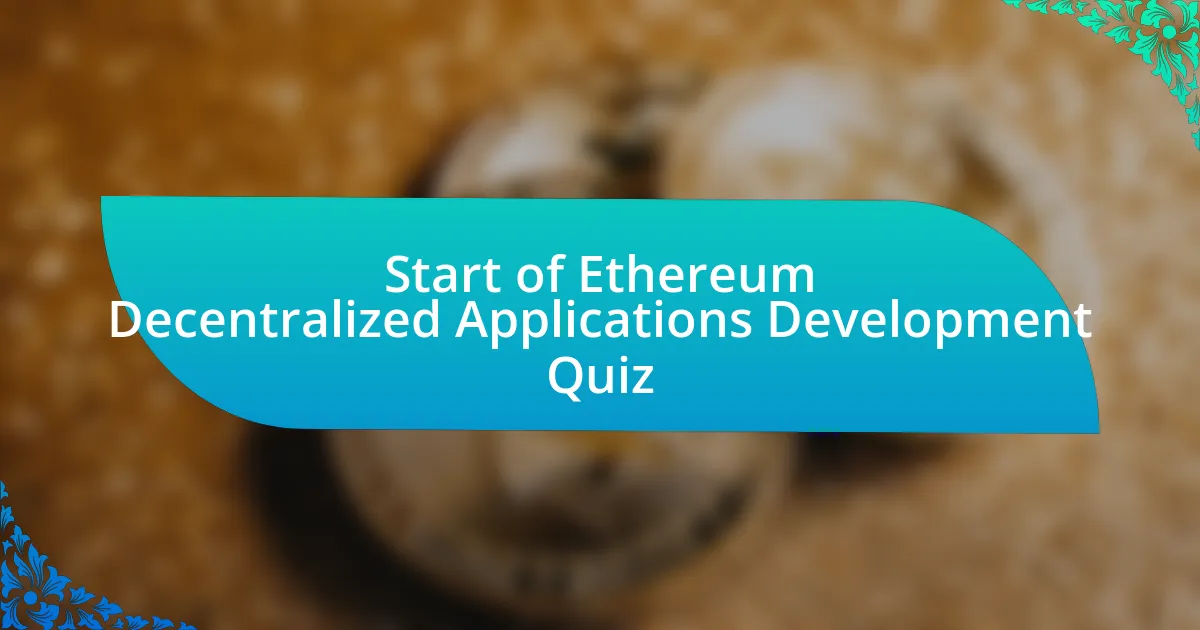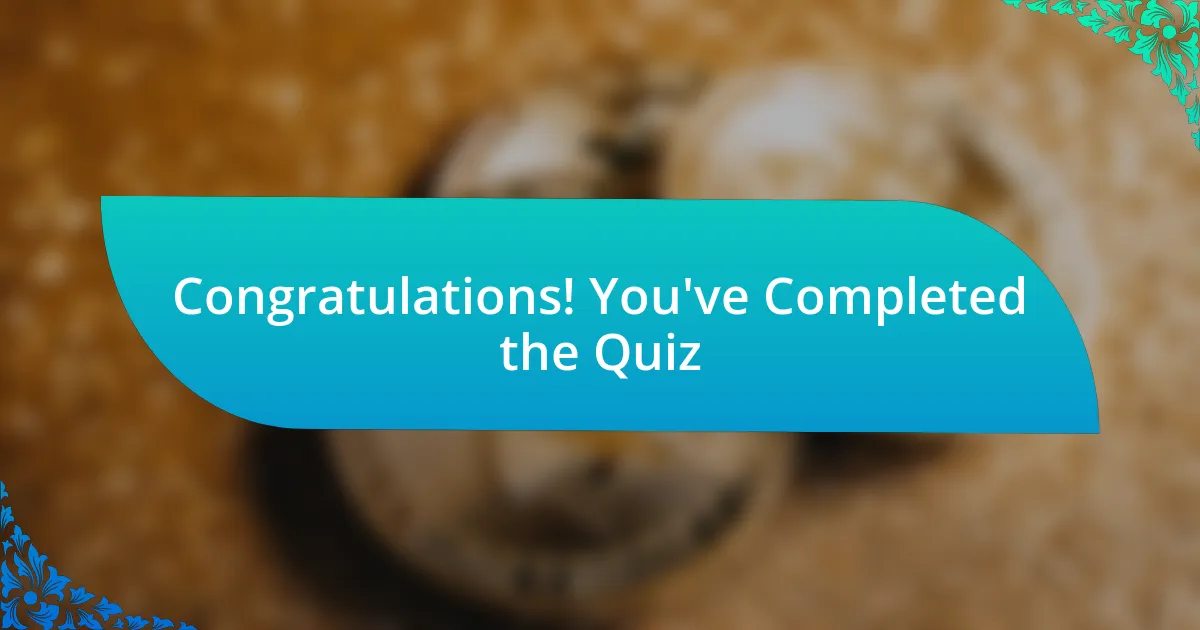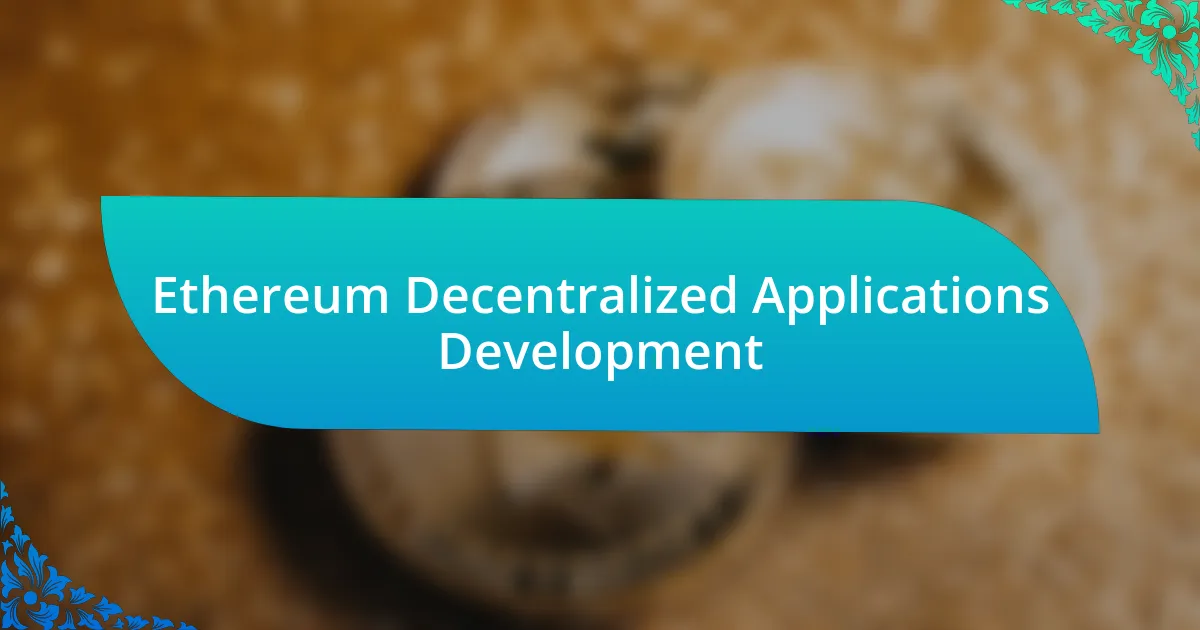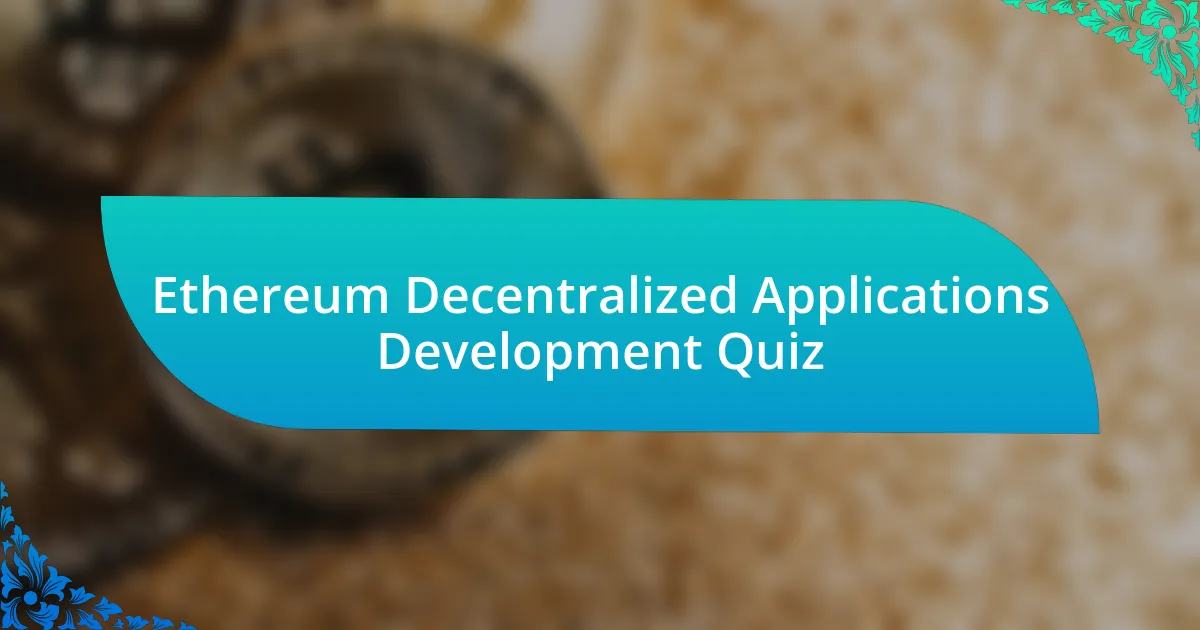
Start of Ethereum Decentralized Applications Development Quiz
1. What is the main difference between a centralized application and a decentralized application (dApp)?
- A decentralized application is hosted on a single computer.
- A centralized application relies on a single server for functionality.
- A centralized application operates without user input.
- A decentralized application is controlled by one person.
2. How do smart contracts enhance the functionality of dApps on Ethereum?
- Smart contracts create a centralized control mechanism for dApps.
- Smart contracts enhance security by eliminating all coding errors.
- Smart contracts automate and enforce self-executing agreements.
- Smart contracts function solely as storage for user data.
3. What programming language is primarily used for writing smart contracts on Ethereum?
- Python
- Solidity
- C++
- JavaScript
4. What role do oracles play in Ethereum decentralized applications?
- Oracles provide real-world data to Ethereum dApps.
- Oracles are used to secure private keys.
- Oracles store transaction history on the blockchain.
- Oracles execute smart contracts autonomously.
5. How can developers monetize their dApps built on the Ethereum network?
- Charging transaction fees for services
- Creating a centralized server
- Selling access to private data
- Offering free services to users
6. What does `gas` refer to in Ethereum smart contracts?
- The storage space needed for a contract
- The number of transactions per second
- The amount of computational work required to execute a transaction
- The programming language used in smart contracts
7. How do Ethereum tokens differ from Ether (ETH)?
- Ethereum tokens are built on the Ethereum blockchain.
- Ether is used for smart contracts only.
- Ether is a governance token for Ethereum.
- Ethereum tokens are entirely centralized.
8. What is a token standard commonly used for creating tokens on Ethereum?
- SLT-30
- ERC-20
- ERC-1155
- ERC-721
9. What is the significance of Ethereum Improvement Proposals (EIPs)?
- EIPs are extensions for Ethereum`s blockchain security.
- EIPs are financial incentives for Ethereum miners.
- EIPs are regulations for Ethereum`s smart contracts.
- EIPs are proposals for improving Ethereum`s protocol.
10. What is the concept of `immutability` within Ethereum smart contracts?
- It refers to the ability to change any part of the contract.
- It signifies that contracts can only be created by one person.
- It means the smart contract code cannot be changed after deployment.
- It indicates the contract can be executed at any time.
11. What is the difference between public and private Ethereum networks?
- Public Ethereum networks are open to everyone, while private networks restrict access.
- Private networks are only for government use.
- Private Ethereum networks are always slower than public ones.
- Public networks require special permissions to access.
12. How does the consensus mechanism in Ethereum affect dApp development?
- It ensures that dApps operate in a secure and efficient manner.
- It requires dApps to use a centralized database for data storage.
- It allows dApps to function only on private blockchains.
- It limits the scalability of dApps significantly.
13. What is the purpose of a crypto wallet in Ethereum dApp interactions?
- To mine Ethereum blocks
- To create new smart contracts
- To modify existing dApps
- To store and manage private keys
14. can you name a popular Ethereum test network?
- Ropsten
- Mainnet
- Testnet
- Kovan
15. What security mechanisms are important for developing secure dApps?
- Proprietary software solutions are important for developing secure dApps.
- Centralized databases are important for developing secure dApps.
- Secure coding practices are essential for developing secure dApps.
- Traditional server management is important for developing secure dApps.
16. What is the role of gas limits in Ethereum transactions?
- Gas limits specify the block size on the Ethereum blockchain.
- Gas limits regulate the number of blocks mined per hour on Ethereum.
- Gas limits determine the total amount of Ether transferred in a transaction.
- Gas limits control the maximum computational work for an Ethereum transaction.
17. How does Ethereum handle upgrades and changes to the network?
- Ethereum fixes issues by reversing blockchain transactions manually.
- Ethereum uses a consensus mechanism to implement upgrades through community consensus.
- Ethereum requires all users to agree in person before upgrades can happen.
- Ethereum upgrades happen automatically without any community input.
18. What are the benefits of using layer 2 solutions for dApps on Ethereum?
- Limited access to blockchain data and functionalities.
- Increased centralization and less security.
- Reduced transaction fees and increased speed.
- Mandatory use of proprietary software for all users.
19. What is the function of the `require` statement in Solidity?
- The require statement checks for specific conditions and reverts the transaction if they are not met.
- The require statement is used to manage gas fees during a transaction.
- The require statement defines the function visibility for contracts.
- The require statement compiles the contract into bytecode for the EVM.
20. How does state management work in Ethereum smart contracts?
- State management in Ethereum smart contracts is achieved through centralized databases for efficiency.
- State management in Ethereum smart contracts does not require any form of data persistence.
- State management in Ethereum smart contracts uses global variables only for data storage.
- State management in Ethereum smart contracts relies on a combination of storage, memory, and computation states.
21. What are pitfalls developers should avoid when coding smart contracts?
- Using outdated programming languages for the contract.
- Ignoring blockchain network fees in the contract.
- Hardcoding sensitive information in the contract.
- Failing to properly test the contract before deployment.
22. What is the significance of event logging in Ethereum smart contracts?
- Event logging ensures smart contracts run faster and require less gas.
- Event logging stores all data permanently on the Ethereum blockchain.
- Event logging allows contracts to emit events for tracking actions and transactions.
- Event logging verifies transactions on the blockchain to enhance security.
23. How does the decentralized nature of dApps provide benefits in terms of censorship resistance?
- Decentralization prevents any single entity from controlling the application, enhancing censorship resistance.
- Decentralization creates more efficient user interfaces that promote censorship.
- Centralization allows for faster updates and easier management, reducing censorship risks.
- Censorship is avoided by only allowing registered users to access dApps.
24. What protocols are commonly used for DeFi applications on Ethereum?
- Chainlink
- Uniswap
- Bitcoin Cash
- Litecoin
25. Why is testing crucial in Ethereum smart contract development?
- It simplifies the coding process for developers.
- It ensures reliability and security of smart contracts.
- It enhances the speed of transactions on the network.
- It minimizes transaction fees during execution.
26. What are common performance issues encountered with Ethereum dApps?
- Unlimited transaction speed
- Total elimination of gas fees
- All transactions being private
- Scalability issues with high user volume
27. How do developers ensure the transparency of operations within a dApp?
- By utilizing smart contracts for transparency
- By keeping source code private
- By deploying a centralized server
- By using traditional databases
28. What are the functions of testing frameworks in Ethereum development?
- Testing frameworks are only for user interface design in Ethereum development.
- Testing frameworks facilitate the marketing of Ethereum applications to users.
- Testing frameworks automate the testing of smart contracts and dApps in Ethereum development.
- Testing frameworks are solely for managing user interactions with dApps.
29. How do multisignature contracts improve security in dApps?
- Multisignature contracts are used to increase transaction speed in dApps.
- Multisignature contracts directly store user data on the blockchain.
- Multisignature contracts eliminate the need for user authentication in dApps.
- Multisignature contracts require multiple approvals for transactions, enhancing security.
30. What is the difference between ERC-20 and ERC-721 token standards?
- ERC-20 allows only fungible tokens; ERC-721 allows fungible and non-fungible tokens.
- ERC-20 is for asset tracking; ERC-721 is for decentralized identity.
- ERC-20 allows fungible tokens; ERC-721 allows non-fungible tokens.
- ERC-20 is limited to Ethereum; ERC-721 works only on Bitcoin.

Congratulations! You’ve Completed the Quiz
Well done on finishing the quiz about Ethereum Decentralized Applications Development! This journey has likely helped you strengthen your understanding of key concepts. From smart contracts to the intricacies of DApp architecture, you may have discovered the vital components that make Ethereum a pioneering platform.
As a result of your participation, you might have learned about the benefits of decentralization and how it empowers users. You’ve seen the potential for innovation in various sectors through blockchain technology. Each question was designed to challenge your knowledge and spark your curiosity about this exciting field.
If you’re eager to dive deeper, we invite you to check out the next section on this page. It’s packed with rich resources about Ethereum Decentralized Applications Development. Here, you can further expand your knowledge and gain valuable insights into building your own decentralized applications. Your exploration doesn’t stop here; happy learning!

Ethereum Decentralized Applications Development
Overview of Ethereum Decentralized Applications (DApps)
Ethereum decentralized applications, known as DApps, are software applications that run on the Ethereum blockchain. They utilize smart contracts to execute backend code and ensure transparency, security, and decentralization. Unlike traditional applications, DApps operate without a central authority. This structure promotes user control and community governance. The most notable features of DApps include immutability, censorship resistance, and the ability to leverage the Ethereum network for processing transactions via its native cryptocurrency, Ether (ETH). These characteristics position Ethereum DApps uniquely in the tech landscape.
Key Components of Ethereum DApp Development
Developing Ethereum DApps involves several critical components. The primary components include smart contracts, the Ethereum Virtual Machine (EVM), and a user interface. Smart contracts are self-executing contracts with the agreement directly written into code. The EVM acts as the runtime environment for executing code and managing DApp operations. Additionally, developers often utilize Web3.js or Ethers.js to facilitate interactions between the DApp and the Ethereum blockchain. These components work together to create a seamless, decentralized experience for users.
Smart Contracts in Ethereum DApp Development
Smart contracts are the backbone of Ethereum DApps. They automate processes and enforce agreements without intermediaries. Written in Solidity or Vyper, smart contracts define rules and execute outcomes based on predefined conditions. This eliminates the possibility of fraud or manipulation. Upon deployment on the Ethereum blockchain, smart contracts become immutable, providing a secure and transparent way to manage transactions and data. Their correct implementation is crucial for the success of any DApp.
Development Tools and Frameworks for Ethereum DApps
Various tools and frameworks streamline Ethereum DApp development. Truffle, for instance, is a popular development framework that simplifies the creation and testing of smart contracts. Ganache, a personal blockchain, allows developers to simulate the Ethereum network for testing purposes. Additionally, tools like Metamask provide essential browser integration, enabling users to manage identities and interact with DApps easily. Each tool enhances the development process, ensuring efficiency and effectiveness.
Challenges in Ethereum DApp Development
Despite its potential, Ethereum DApp development faces several challenges. Scalability remains a significant issue, as the network can become congested and lead to high transaction fees. Security also poses risks, as poorly written smart contracts can be vulnerable to attacks. Additionally, user experience can be complex due to the need for wallets and gas management. Addressing these challenges requires ongoing innovation and adaptation within the development community.
What are Ethereum Decentralized Applications (dApps)?
Ethereum Decentralized Applications (dApps) are software applications that run on a blockchain network, specifically the Ethereum blockchain. They utilize smart contracts to enable trustless transactions and interactions between users. Unlike traditional applications, dApps function without a central authority, allowing peer-to-peer exchanges. A notable feature is their ability to operate autonomously once deployed. As of 2023, over 4,000 dApps exist on the Ethereum platform, highlighting their growing adoption.
How are Ethereum dApps developed?
Ethereum dApps are developed using programming languages like Solidity, which is specifically designed for writing smart contracts on the Ethereum network. Developers start by defining the smart contract’s logic and conditions. Then, they deploy the contract to the Ethereum blockchain. Development tools like Truffle, Hardhat, and Remix facilitate building, testing, and deploying dApps. There are more than 700,000 developers working on Ethereum-related projects as of 2023, indicating a robust development environment.
Where can Ethereum dApps be found?
Ethereum dApps can be found on various platforms such as decentralized exchanges (DEXs), wallets, and NFT marketplaces. Popular dApps include Uniswap for trading tokens, OpenSea for buying and selling NFTs, and Compound for lending and borrowing cryptocurrencies. They are also accessible via Ethereum-compatible wallets, like MetaMask, allowing users to interact directly with the applications through their web browsers. The Ethereum blockchain’s open-source nature enables anyone to access these dApps globally.
When were Ethereum dApps introduced?
Ethereum dApps were introduced with the launch of the Ethereum network in July 2015. The concept gained significant traction in 2017, coinciding with the initial coin offering (ICO) boom, where many projects relied on dApps for fundraising. The growing demand for decentralized solutions led to a rapid increase in the number and complexity of dApps post-2017. By 2021, daily active users of Ethereum dApps had surged to over 1 million.
Who develops Ethereum dApps?
Ethereum dApps are developed by a wide range of individuals and organizations, including independent developers, startups, and established companies. A large community of developers contributes to the ecosystem, aided by open-source resources available on platforms like GitHub. Many coding bootcamps and universities also offer courses on blockchain and Ethereum development, which has further increased the number of developers entering the space. Notable firms like ConsenSys, which develops various Ethereum tools and applications, play a significant role in the dApp development landscape.

